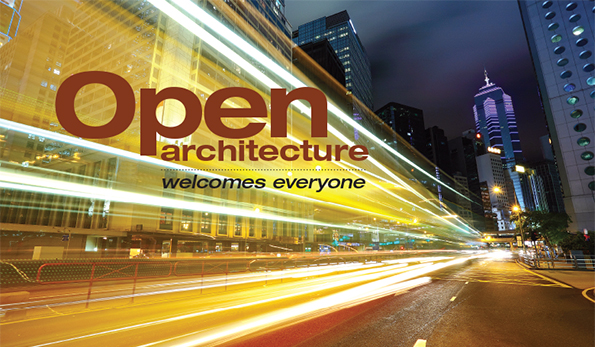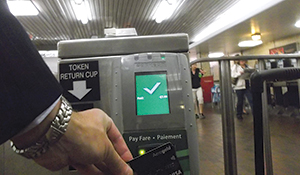
Accenture’s Michael J. Wilson explains how new technology creates competitive choices
By Richard Tackett

Accenture, New York, NY, one of the world’s foremost transportation consulting, technology and outsourcing organizations, has been a leader in pushing public transportation toward its digital future. At the request of BUSRide, Michael J. Wilson, Accenture’s managing director for Public Transportation, North America, addressed questions about open architecture and explained how it is driving next-generation transportation.
—————————————————————————————————————————————
YOU MIGHT ALSO LIKE:
- Safety through information delivery
- Get onboard with security
- Vix Technology: EasyandOpen
- More than a map from Rand McNally
—————————————————————————————————————————————
Briefly define open architecture.
One definition is that open architecture is modular in its makeup. In the case of fare management, that means integrating multiple device vendors and suppliers. Traditional closed systems tend to have one equipment supplier with one system behind it. Open architectures allow multiple device vendors, creating a competition in choice.
Another definition for open architecture is the type of backend software involved. Most fare management systems have financial management, custom management and asset management departments. There are some commercial software packages out today that do all of those functions, and open architecture makes those packages available for transit. By leveraging those products, an agency is able to get ongoing upgrades and support.

Another element of an open system is integration architecture. Open architecture can easily plug and play with multiple external systems and multiple forms of payment in a way that’s easy to keep up-to-date and adaptable to future changes.
Can you explain the difference between open architecture and open payments?
Interestingly, there’s still some confusion in the marketplace about open architecture versus open payments. You might see these terms used interchangeably, but they’re not the same.
Open architecture is about the various elements needed to create the modular system, whereas open payments are more about the choice you have in asking for payment media. Open payments are about payment media. Open architecture is important because, when an agency wants a choice, our systems need to be flexible and modular enough to support those different choices.
What’s a sign that a transit agency should consider open architecture?
In terms of the software, when an agency realizes its ability to dynamically move to some new payment mechanisms is being hampered – that might be a reason to consider replacement of that software and a move to open architecture.
Many transit agencies are facing financial cutbacks and are averse to major changes. What’s the solution for them?

What’s interesting about open architecture is that the business case is pretty strong. We did a research paper published earlier this year, Accelerating the Payback from Fare Collection Investment. Typically we’re seeing transit agencies report that 15 percent of their revenue goes into fare collection costs. That’s a significant number. When we looked at the expenditure analysis, we saw the opportunity to cut those costs by 6 percent with open architecture. When we look at the cost of purchasing these open systems, we’re seeing paybacks within three to five years.
What benefits will transit customers see from open architecture?
The big advantage is that customers get access to new choices. Instead of providing only traditional magnetic stripe media, the access to smartphone embedded wallets like Google Wallet or ISIS, contactless credit cards or standard credential cards means a lot. For the consumer, it means greater choice and access to already existing retail forms of payment.
Additionally, with open architecture, agencies can stay current in terms of new and emerging technologies.
What goes into managing a truly open system?
In some ways, reduced management costs are why we’re seeing a cheaper total cost of ownership. In some ways, it’s easier to manage. The more traditional systems are dealing with older equipment which requires significantly more maintenance. We’re seeing maintenance effort reduced with open systems.
Also, traditional transit systems require customers to convert their currency into the agency’s payment media. This allows agencies to move out of the business of that exchange. It translates into less equipment and less energy put into managing that media.
Your report made mention of outsourcing management of open architecture systems. Please elaborate.
When you move to open architecture, you’re basically leveraging commercial software that’s readily available in the marketplace. Microsoft, for example, has a marketplace of people that can manage and maintain Microsoft software. Agencies can choose who they want to provide the software, but also who they want to maintain it. In a closed system, you’re relying on the manager or vendor you’ve contracted with.

Does open architecture aid in data collection?
It absolutely helps with data collection. When you move to these commercial products, they’re set up to work with most standard analytic and reporting packages. You can easily leverage the data from these standard packages for whatever analytical uses you have. With a proprietary system, however, the data and approaches are often more closed in their structure and more difficult to access.
With all of its advantages, why isn’t all of America already on board with open architecture?
We’re starting to see this terminology make it into requests for proposals (RFP). Toronto was probably one of the first cities in North America that went to a “systems integration” approach, promoting open architecture. Washington Metro recently awarded its contract to Accenture, and again the premise was an open architecture systems integration approach.
What’s the future hold for open systems?
We don’t know what we don’t know, and that’s why it’s important to set up these kinds of systems to be adaptable. It’s interesting to continue to monitor what’s happening in the mobile space. There’s more of an emphasis on what customers already have in their pocket, with less and less need for transit agencies to spend on costly infrastructure.
